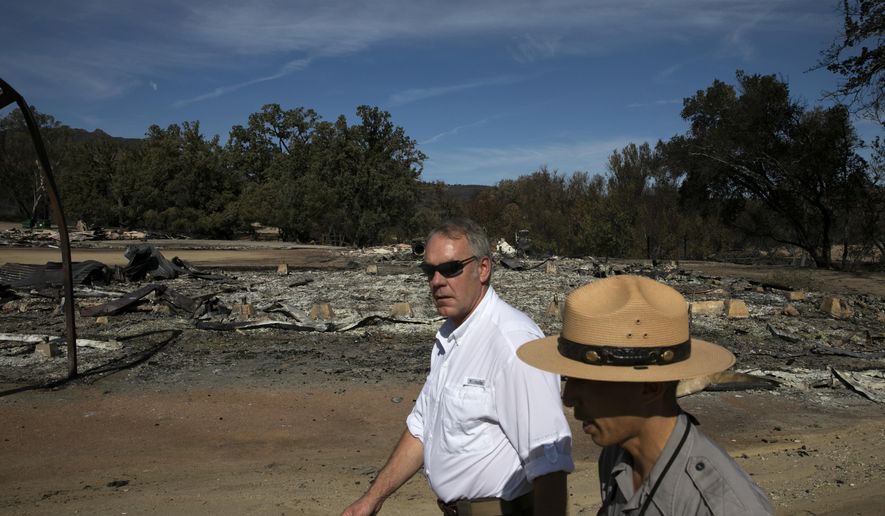Interior Secretary Ryan Zinke blamed “radical environmentalists” Tuesday for blocking federal forest-management efforts and causing dangerous conditions that lead to deadly wildfires such as the blaze that has killed more than 80 people in northern California.
“When lawsuit after lawsuit by, yes, the radical environmental groups that would rather burn down the entire forest than cut a single tree or thin the forest, then it’s easy to find who is suing and who promulgates these destructive policies,” Mr. Zinke said. “Take a look at who’s suing — every time there’s a thinning project. The density of dead and dying trees is higher.”
He added, “When nature alone takes its course without management, there are consequences. The special-interest groups are really exercising their very tight agenda.”
Mr. Zinke and Agriculture Secretary Sonny Perdue held a conference call with reporters to urge Congress to give the administration more flexibility to remove dead trees and carry out more “prescribed burns” to prevent devastating wildfires. The Camp fire in northern California has killed 81 people, with 700 others unaccounted for, and destroyed more than 10,000 homes.
“It was literally like a flame-thrower of embers,” Mr. Zinke said of the wind-driven fire. “The talking’s over, now it is time to act. We need to prioritize getting back to an active [forest] management system. This is the time to act. This is not a Republican or Democrat issue. This is an American issue.”
California’s Democratic leaders, who prefer to blame the fires on global warming from fossil-fuel emissions, say the Trump administration isn’t correct anyway because most of California’s recent fires have been in brush-covered grasslands, not in forests, and thus thinning trees would not have avoided them.
But Mr. Perdue said lawmakers could amend the farm bill under negotiation to give federal agencies more leeway to clear away brush and work with local governments to create more buffer zones around populated areas. He said federal agencies have had to borrow money from fire prevention budgets to pay for emergency firefighting, a situation that will change in fiscal 2020.
The agriculture secretary agreed that the government’s hands have been tied by “well-meaning” environmentalists.
“A well-managed, well-groomed forest is always better,” he said. “I think some are coming around to that way of thinking. We need more to come along, and we need the lawsuits to stop.”
Meanwhile in California, more lawsuits have been filed, according to plaintiffs’ attorneys Tuesday. This one is a class-action lawsuit blaming a power company for not shutting off power before a Southern California fire started.
Nearly 20 property-damage victims of the Woolsey Fire are part of the class-action lawsuit against Southern California Edison, which was filed last week in Los Angeles Superior Court, lawyers told the Associated Press on Tuesday.
The court filing, which represents only one point of view, claims Edison contributed to the fire by ignoring warnings of extreme fire weather and keeping the power going in the dangerous situation.
The cause of that fire has not been determined.
The California Department of Forestry and Fire Protection said Tuesday that the deadly Northern California fire, which covers 236 square miles, is now 70 percent contained, up from 66 percent Monday morning.
There was also good news on the weather front as the region is expected to start receiving rain Wednesday, a forecast that lasts through the Thanksgiving weekend.
Still, the National Weather Service has issued a flash-flood watch for the wildfire-scarred areas, explaining newly burned areas are prone to downhill ash and debris. These refuse flows could complicate efforts to find human remains by washing away signs of the dead or turning dusty debris into a thick paste.
⦁ This article was based in part on wire-service reports.
• Dave Boyer can be reached at dboyer@washingtontimes.com.




Please read our comment policy before commenting.